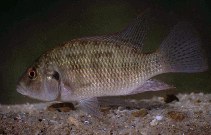| Family: |
Cichlidae (Cichlids), subfamily: Pseudocrenilabrinae |
| Max. size: |
39 cm TL (male/unsexed); max.weight: 2,210.0 g; max. reported age: 7 years |
| Environment: |
demersal; freshwater, |
| Distribution: |
Africa: Okovango River system, upper and middle Zambezi River system, Kafue River (Angola, Namibia, Botswana, Zambia and Zimbabwe)(Ref. 7248). Also reported from the Kunene (Ref. 120641). |
| Diagnosis: |
Dorsal spines (total): 9-9; Dorsal soft rays (total): 10-10; Anal spines: 3-3; Anal soft rays: 8-8. Description: deep-bodied; resembles S. carlottae but has a longer and more pointed snout; frontal profile straight to slightly concave; caudal fin rounded (Ref. 52307).
Coloration: snout, front, back and sides of body olive, belly light green; scales on dorsum often with a rusty brown spot at centre; cheeks and opercles greenish to bluish; fins light to medium green (Ref. 52307). Adult males: colors more intense when courting; head and pelvic fins often turn dark blue, while posterior edge of caudal fin becomes reddish; soft dorsal and anal fin portions with many orange dots, better developed in the latter; several rows of brownish maculae may be present in the caudal fin (Ref. 52307). |
| Biology: |
Found in shallow fringes in heavily vegetated areas but prefers deep, quiet water, slow-flowing channels and floodplain lagoons (Ref. 7248). Feeds on Nymphaea seeds, water insects, mollusks and fish material (scales of large cichlids) (Ref. 6465). Ovophilic, agamous (Ref. 52307) female mouthbrooder (Ref. 7248, 52307). Breeds in summer, probably spawning twice in the season; males mature at 15 cm, females at 12.5-15.0 cm; used as a snail control agent (Ref. 7248). |
| IUCN Red List Status: |
Least Concern (LC); Date assessed: 01 March 2007 Ref. (130435)
|
| Threat to humans: |
harmless |
Source and more info: www.fishbase.org. For personal, classroom, and other internal use only. Not for publication.

